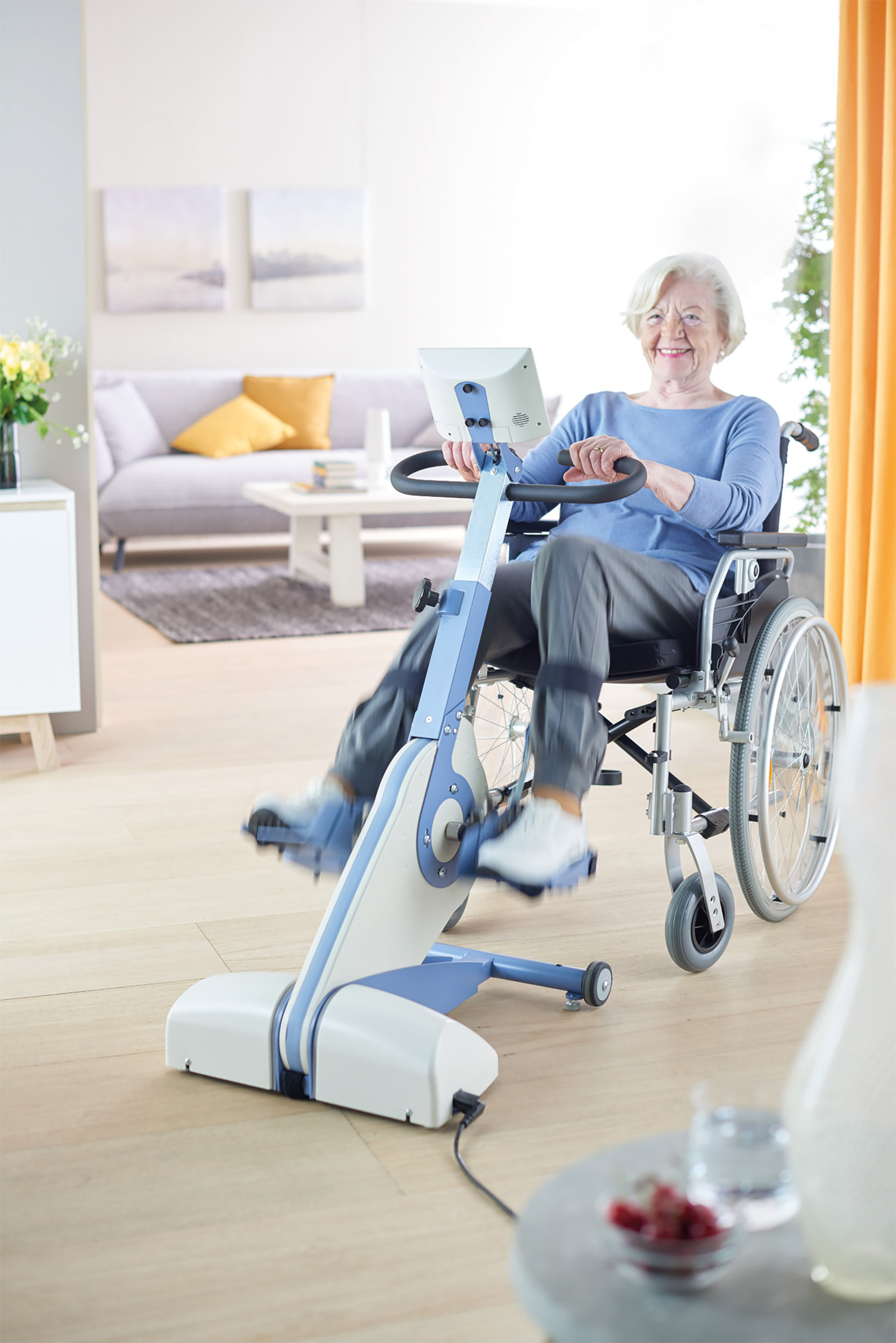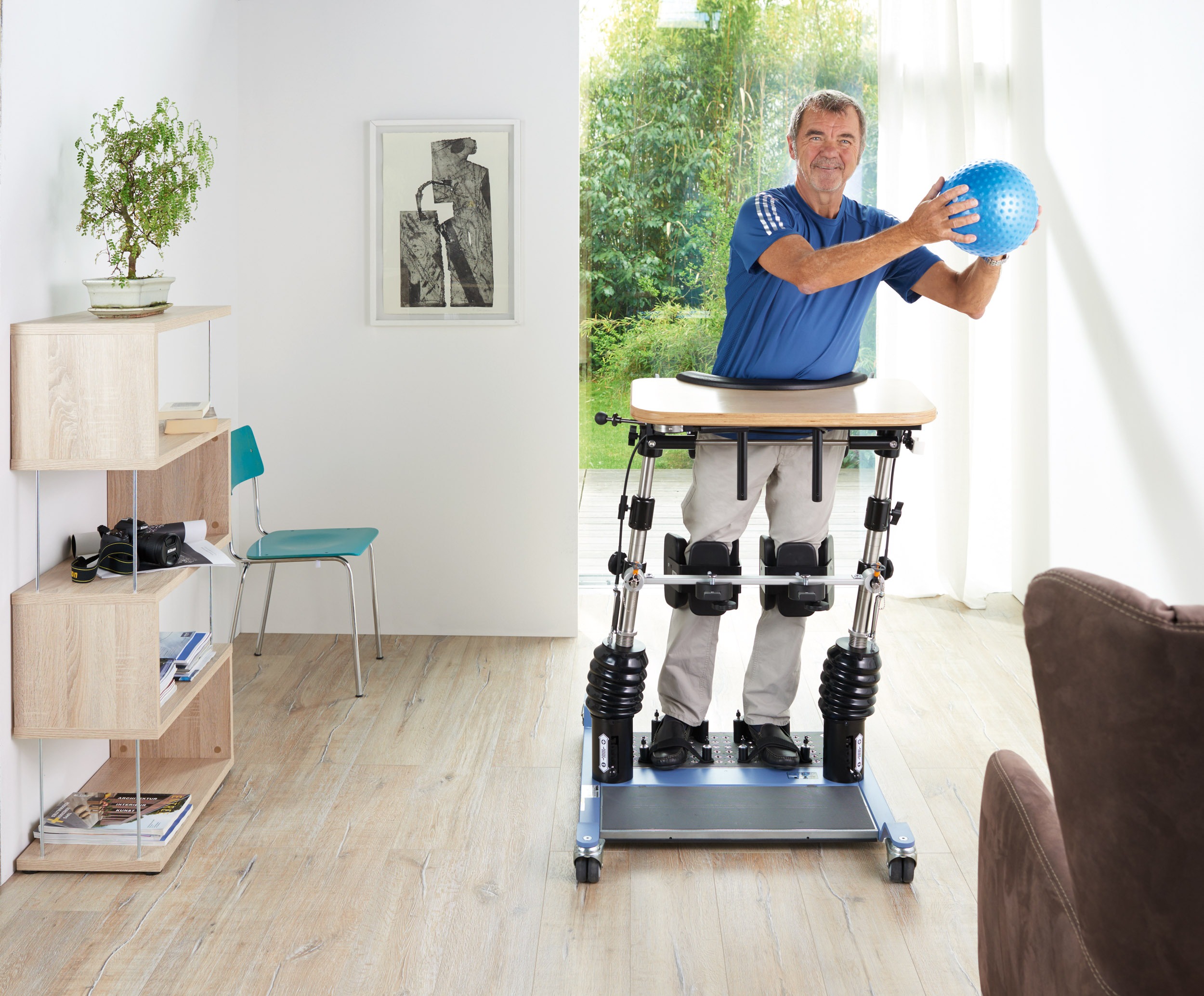
THERAPY-Magazin
Ambient Assisted Living (AAL)
Discover how AAL technologies enhance quality of life for older adults by promoting mobility, fall prevention, and daily independence. Learn how digital innovation empowers healthy ageing.

Jakob Tiebel
Health Business Consultant
Digitalisation to promote social participation in old age
Digitalisation demands and promotes a societal transformation that has now encompassed all facets of our daily lives [3]. The revolution triggered by highly developed microelectronics and computer technology, which has led us into an increasingly digitalised world since the end of the 20th century, is comparable to the industrial revolution that transformed us into an industrial society about 200 years ago [4].
A major objective of this digital revolution is to bring about more prosperity and quality of life [1]. Digital innovations should do one thing above all: make our lives easier. For the vast majority of younger people, i.e. “digital natives” who have already grown up with modern technologies, this is undoubtedly true. For them, moving in the digital world and capitalising on its advantages comes naturally [2,5]. But what about the older people in our society, who are generally considered to be much less familiar with digital innovation compared to younger people?
A major objective of this digital revolution is to bring about more prosperity and quality of life [1]. Digital innovations should do one thing above all: make our lives easier. For the vast majority of younger people, i.e. “digital natives” who have already grown up with modern technologies, this is undoubtedly true. For them, moving in the digital world and capitalising on its advantages comes naturally [2,5]. But what about the older people in our society, who are generally considered to be much less familiar with digital innovation compared to younger people?
Openness towards digitalisation despite older age
Digital change obviously also offers opportunities for the older generation. Fear of modern technologies is disappearing and older people are discovering the digital world more and more for themselves [6].
“Older people are open to digitalisation; they are curious and want to become active and capable players in digital society. Digitalisation must be designed to encourage this curiosity. It must produce sovereign digital actors who can competently use the variety of digital technologies to participate in social life in a self-determined way for as long as possible” [6].
This development process is stimulated by the increasingly emergent properties of digital systems, which can make life easier, especially in old age. Examples include digital support for everyday activities such as shopping, simplified communication with grandchildren living far away, as well as telemedical approaches and digitally supported care and rehabilitation services [6].
Digital change obviously also offers opportunities for the older generation. Fear of modern technologies is disappearing and older people are discovering the digital world more and more for themselves [6].
“Older people are open to digitalisation; they are curious and want to become active and capable players in digital society. Digitalisation must be designed to encourage this curiosity. It must produce sovereign digital actors who can competently use the variety of digital technologies to participate in social life in a self-determined way for as long as possible” [6].
This development process is stimulated by the increasingly emergent properties of digital systems, which can make life easier, especially in old age. Examples include digital support for everyday activities such as shopping, simplified communication with grandchildren living far away, as well as telemedical approaches and digitally supported care and rehabilitation services [6].
When megatrends like digitalisation and demographic changes intertwine
The idea of using digitalisation explicitly to promote social participation in old age has given rise to an area of independent research and development called “Ambient Assisted Living” (AAL), promoted by national and European funding bodies, including for science and technology.
AAL brings the megatrends of digitalisation and demographic change together. AAL encompasses diverse methods, concepts, systems, products and services that are intended to support the lives of older people in a situational and unobtrusive manner. The assistance systems are specifically designed to make it easier for older people to live in their own homes for as long as possible and to participate in social life in a self-determined way.
AAL research is focused on adapting public services to a growing number of older people and their needs [6]. The field is interdisciplinary, practically oriented and includes behavioural and technical aspects. As physical activity in particular is an essential part of a self-determined life, AAL is an especially exciting field in this area. Numerous digital applications are specifically designed to preserve this important determinant of autonomy and independence in old age [6].
The idea of using digitalisation explicitly to promote social participation in old age has given rise to an area of independent research and development called “Ambient Assisted Living” (AAL), promoted by national and European funding bodies, including for science and technology.
AAL brings the megatrends of digitalisation and demographic change together. AAL encompasses diverse methods, concepts, systems, products and services that are intended to support the lives of older people in a situational and unobtrusive manner. The assistance systems are specifically designed to make it easier for older people to live in their own homes for as long as possible and to participate in social life in a self-determined way.
AAL research is focused on adapting public services to a growing number of older people and their needs [6]. The field is interdisciplinary, practically oriented and includes behavioural and technical aspects. As physical activity in particular is an essential part of a self-determined life, AAL is an especially exciting field in this area. Numerous digital applications are specifically designed to preserve this important determinant of autonomy and independence in old age [6].

Healthcare-related research, development and evaluation
That is why THERA-Trainer has been a committed supplier of technology in this area for many years. The goal: to increase or maintain the quality of life of people with potential or existing assistance needs through the use of AAL technologies.
Numerous exciting and promising research and development projects have already been realised in recent years, including with the Felix Platter Hospital in Basel, Switzerland (cf. THERAPY 2018-1), the AAL Living Lab at Kempten University of Applied Sciences, Germany (cf. THERAPY 2019-1), Dividat, Switzerland (THERAPY 2023-1) and the Austrian medical technology cluster VR4 Mind&Motion (cf. THERAPY 2023-1).
In addition to the development of new technologies for geriatric medicine, the evaluation of user barriers, technical barriers, market barriers and network barriers in particular played a major role in these projects. Both from the perspective of the patients and their particular needs and local circumstances, as well as systemically, across organisations and borders.
That is why THERA-Trainer has been a committed supplier of technology in this area for many years. The goal: to increase or maintain the quality of life of people with potential or existing assistance needs through the use of AAL technologies.
Numerous exciting and promising research and development projects have already been realised in recent years, including with the Felix Platter Hospital in Basel, Switzerland (cf. THERAPY 2018-1), the AAL Living Lab at Kempten University of Applied Sciences, Germany (cf. THERAPY 2019-1), Dividat, Switzerland (THERAPY 2023-1) and the Austrian medical technology cluster VR4 Mind&Motion (cf. THERAPY 2023-1).
In addition to the development of new technologies for geriatric medicine, the evaluation of user barriers, technical barriers, market barriers and network barriers in particular played a major role in these projects. Both from the perspective of the patients and their particular needs and local circumstances, as well as systemically, across organisations and borders.
Continuing the search for concepts to care for an ageing society
THERA-Trainer will continue to participate in this field of research and development in the future. Demographic change today is already demanding, with increasing severity, suitable concepts to care for the ageing society of tomorrow. Particular emphasis will be placed on the areas of strength, endurance and mobility as well as balance training and fall prevention. But new software technologies and the use of virtual reality will also become increasingly important. Research institutions around the world are invited to jointly develop and implement new digital innovations.
THERA-Trainer will continue to participate in this field of research and development in the future. Demographic change today is already demanding, with increasing severity, suitable concepts to care for the ageing society of tomorrow. Particular emphasis will be placed on the areas of strength, endurance and mobility as well as balance training and fall prevention. But new software technologies and the use of virtual reality will also become increasingly important. Research institutions around the world are invited to jointly develop and implement new digital innovations.
Fachkreise
Technology & Development
THERAPY 2023-II
THERAPY Magazine
Wohnen im Alter & Langzeitpflege

Jakob Tiebel
Health Business Consultant
Jakob Tiebel is OT and studied applied psychology with a focus on health economics. He has clinical expertise from his previous therapeutic work in neurorehabilitation. He conducts research and publishes on the theory-practice transfer in neurorehabilitation and is the owner of an agency for digital health marketing.
References:
- Bundesministerium für Wirtschaft und Energie, BMWI (2019). Den digitalen Wandel gestalten. Online zugegriffen am 23. Januar 2023: https://www.bmwk.de/Redaktion/DE/Dossier/digitalisierung.html
- Günther J (2007). Digital Natives & Digital Immigrants. Innsbruck: Studienverlag.
- Lang FP (2019). Quo vadis Digitale Revolution? In: Hermeier B, Heupel T, Fichtner-Rosada S (eds) Arbeitswelten der Zukunft. FOM-Edition (FOM Hochschule für Oeko-nomie & Management). Wiesbanden: Springer Gabler.
- Lauterbach M, Hörner K (2019) Erfolgsfaktoren in der Digitalisierung der Gesund-heitsversorgung. In: Haring R. (eds) Gesundheit digital. Springer, Berlin, Heidelberg.
- Margaryan A, Littlejohn A, Vojt G (2010). Are digital natives a myth or reality? Uni-versity students’ use of digital technologies. Computers & Education 56 (2): 429-440.
- Weiß C, Stubbe J, Naujoks C. et al. (2017). Digitalisierung für mehr Optionen und Teilhabe im Alter. 1. Auflage, Gütersloh: Bertelsmann-Stiftung.
Related contents
Find related exciting contents in our media library.
This is not what you are searching for? Knowledge
Meet our specialists.
Are you interested in our solutions? Schedule a meeting with a Consultant to talk through your strategy and understand how TEHRA-Trainer can help you to advance rehabilitation.
You need to load content from reCAPTCHA to submit the form. Please note that doing so will share data with third-party providers.
More InformationYou are currently viewing a placeholder content from Turnstile. To access the actual content, click the button below. Please note that doing so will share data with third-party providers.
More Information